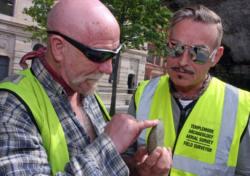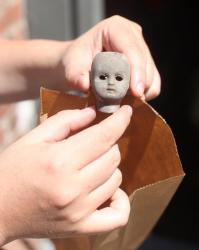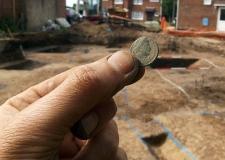INSTITUT SUPERIEUR D'ANTHROPOLOGIE
INSTITUTE OF ANTHROPOLOGY
ONLINE COURSES / COURS A DISTANCE
INSCRIPTION : Année Universitaire 2012/2013
REGISTRATION : Academic Year 2012 / 2013
ULSTER –  Derry - Local archaelogists say a 6,000 year old stone axe head has been discovered in the Creggan area of the city. Ian Leitch, of Templemore Archaeology, believes the prehistoric artefact - which was discovered by a member of the public - dates from the Neolithic period: circa 4,000 BC. Mr. Leitch says the axe was probably made by people who first introduced agriculture to the Foyle Valley some 6,000 years ago. He believes it’s the first of its kind discovered in the Creggan area. He revealed that the axe head was polished - a factor, he says, that points to its Neolitic origins. In 2000, a major site dating from the same period was partially excavated in the Thornhill area of the city. Mr. Leitch said this site - which is located in the grounds of the new Thornhill College - comprised more than 20 houses, fortifications, and thousands of artefacts - including stone axes, stone beads and arrow heads. The site is now a scheduled monument protected from future excavation. Archaeologists believe the New Stone age settlement was possibly the site of Ireland’s first farming community. The size of the settlement suggests that up to 50 people could have lived within it. The first people came to Ireland around 8000 BC. These were the Mesolithic, Middle Stone Age, people who were hunter-gatherers. They were replaced by the first farmers in Europe, the Neolithic, who first reached Ireland in about 4500 BC.
Derry - Local archaelogists say a 6,000 year old stone axe head has been discovered in the Creggan area of the city. Ian Leitch, of Templemore Archaeology, believes the prehistoric artefact - which was discovered by a member of the public - dates from the Neolithic period: circa 4,000 BC. Mr. Leitch says the axe was probably made by people who first introduced agriculture to the Foyle Valley some 6,000 years ago. He believes it’s the first of its kind discovered in the Creggan area. He revealed that the axe head was polished - a factor, he says, that points to its Neolitic origins. In 2000, a major site dating from the same period was partially excavated in the Thornhill area of the city. Mr. Leitch said this site - which is located in the grounds of the new Thornhill College - comprised more than 20 houses, fortifications, and thousands of artefacts - including stone axes, stone beads and arrow heads. The site is now a scheduled monument protected from future excavation. Archaeologists believe the New Stone age settlement was possibly the site of Ireland’s first farming community. The size of the settlement suggests that up to 50 people could have lived within it. The first people came to Ireland around 8000 BC. These were the Mesolithic, Middle Stone Age, people who were hunter-gatherers. They were replaced by the first farmers in Europe, the Neolithic, who first reached Ireland in about 4500 BC.
http://www.derryjournal.com/news/local/prehistoric-axe-head-found-1-4112863
USA –  Boise - The Cyrus Jacobs/Uberuaga House has revealed many treasures through the years: marbles, silverware, shoes, tobacco tins. A new excavation began at the site Tuesday and promises to reveal even more about domestic life in Boise’s earliest days. A University of Idaho archaeological team will spend the next two weeks digging out an old well found at the east side of the house. What’s remarkable about the dig is that no one knew the well was there until May, said Patty Miller, executive director at the Basque Museum and Cultural Center. Archaeological crews will remove dirt from around the well, hoping to uncover items lost or thrown away by people nearly 150 years ago. The house and well were built in 1864. For context, that’s one year after the city of Boise was platted and one year before the Civil War ended.
Boise - The Cyrus Jacobs/Uberuaga House has revealed many treasures through the years: marbles, silverware, shoes, tobacco tins. A new excavation began at the site Tuesday and promises to reveal even more about domestic life in Boise’s earliest days. A University of Idaho archaeological team will spend the next two weeks digging out an old well found at the east side of the house. What’s remarkable about the dig is that no one knew the well was there until May, said Patty Miller, executive director at the Basque Museum and Cultural Center. Archaeological crews will remove dirt from around the well, hoping to uncover items lost or thrown away by people nearly 150 years ago. The house and well were built in 1864. For context, that’s one year after the city of Boise was platted and one year before the Civil War ended.
http://www.idahostatesman.com/2012/08/01/2210943/latest-basque-block-dig-has-exciting.html
ROYAUME UNI –  South Creake - Roman artefacts including pottery, coins and jewellery have been discovered that are thought to date back to the end of the third century. The dig came about after Craig Yarham, of North Creake, submitted plans to build a house on Winston Drive, South Creake, last year. However, various Roman coins had been discovered in other parts of the area. An investigation by Giles Emery of Norvic Archaeology later confirmed the presence of Roman artefacts, which then led to the current dig as a condition associated with the development of the property. Mr Emery said: “Although South Creake is located close to the routes of two Roman roads, aside from the discovery of a hoard of Roman coins in 1799, no Roman activity has been reported in the area before.” The area which was excavated is thought to have been a small villa or farmstead. Fragments of pottery, coins and a brooch have been found so far, however the full results of the finds will be analysed at a later date. As well as Roman artefacts, items such as prehistoric flint shards were discovered that date from the late Neolithic to early Bronze Age, which added another 2,500 years to the discoveries of the dig.
South Creake - Roman artefacts including pottery, coins and jewellery have been discovered that are thought to date back to the end of the third century. The dig came about after Craig Yarham, of North Creake, submitted plans to build a house on Winston Drive, South Creake, last year. However, various Roman coins had been discovered in other parts of the area. An investigation by Giles Emery of Norvic Archaeology later confirmed the presence of Roman artefacts, which then led to the current dig as a condition associated with the development of the property. Mr Emery said: “Although South Creake is located close to the routes of two Roman roads, aside from the discovery of a hoard of Roman coins in 1799, no Roman activity has been reported in the area before.” The area which was excavated is thought to have been a small villa or farmstead. Fragments of pottery, coins and a brooch have been found so far, however the full results of the finds will be analysed at a later date. As well as Roman artefacts, items such as prehistoric flint shards were discovered that date from the late Neolithic to early Bronze Age, which added another 2,500 years to the discoveries of the dig.
http://www.edp24.co.uk/news/roman_past_uncovered_in_south_creake_1_1466000